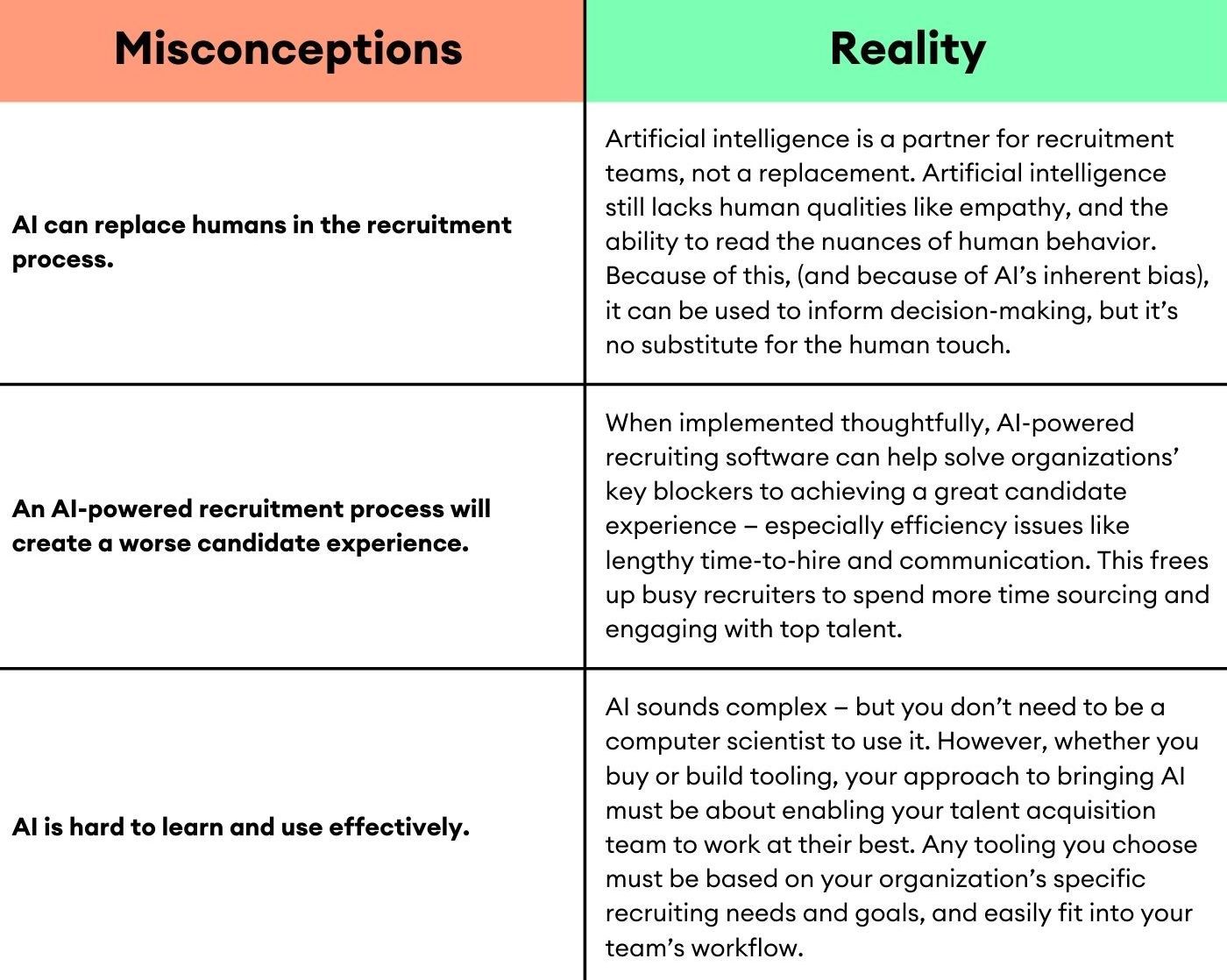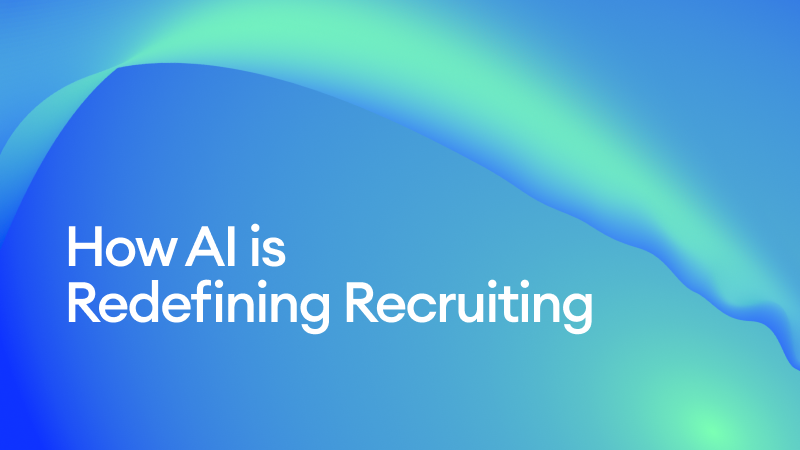Artificial intelligence has catapulted recruiting into a new age of discovery.
Its possibilities are huge, and chameleonic: It can be a candidate matchmaker, a recruiting oracle that predicts future gaps in your workforce, and an administrative task machine that not only completes work more quickly and accurately, but can suggest better ways of getting it done altogether.
AI has the potential to optimize the quality, speed, and accuracy of our ability to recruit new hires, while significantly decreasing the cost and time burden. 81% of talent leaders have already dabbled in the technology — and in years to come, it’s not only going to reshape how you hire, it's going to define your ability to find top talent.
But implementing AI effectively in your organization’s recruitment process to achieve these results depends on understanding the basics of how it works, what it can do, what it can’t do, and some practical applications in the recruiting process.
In this guide, you will learn:
- What AI is and its potential uses in recruitment
- Misconceptions about implementing AI in your hiring process
- Potential challenges when using AI tools
- What’s possible with AI right now — and how AI could reshape recruiting in the future
Understanding AI in recruiting
For many of us, our understanding of artificial intelligence has been informed by a steady diet of Hollywood blockbusters. We’re more likely to bring to mind fantastical images of robo-recruiters and omniscient supercomputers that can pick the best candidates from a huge talent pool than the actual reality.
To understand the impact of AI in recruitment, we need to first understand the basics behind the technology.
Artificial intelligence is an umbrella term that refers to the broader scope of using computers to perform complex tasks that would typically require human intelligence. In a recruiting context, examples of its application include:
- Screening resumes and job descriptions using Natural Language Processing (NLP) to identify specific skills and capabilities for faster shortlisting.
- Automating repetitive, high-volume tasks, like personalizing candidate emails, or scheduling interviews.
- Using a machine learning model to quickly generate job descriptions according to specific hiring criteria.
- Providing job seekers with information on a role without the need for recruiter assistance using a chatbot.
- Automatically summarizing interview notes for hiring managers, and identifying key discussion topics using an AI notetaker.
With a wealth of AI recruiting tools already on the market, hiring has never been more primed for innovation. So what’s holding teams back from taking the plunge into a fully AI-powered recruitment process?
According to 2023 research by Gartner, it’s uncertainty. 76% of talent leaders believe that if their organization doesn’t adopt AI within the next two years, they will get left behind. But 60% of them also feel uncertain on how AI will impact the HR and talent function.
AI is always evolving as a technology, which means we’re still testing the limits of what it can do. And it’s precisely this gap between the urgency to implement AI and uncertainty of how it will redefine the hiring process that’s leaving a lot of room for misconceptions to take root.

Benefits of AI in recruiting
When hiring teams are thoughtful about their application of AI across the recruiting process, it can lead to huge gains in efficiency, accuracy, and quality of hire.
Increase recruiting team efficiency and productivity
When time and resources are in short supply, dealing with a deluge of repetitive tasks means recruiters can’t devote their time to finding — or attracting — the best candidates.
In this context, AI is a no-brainer. A 2023 study found that generative AI (like ChatGPT) can increase worker productivity by 14%. Meanwhile, 2020 research found that AI can increase efficiency in talent acquisition processes when used for task simplification and automation.
Implementing AI for administrative tasks, like screening candidates or entering candidate data, can not only lead to huge efficiency and productivity gains, but also increases the overall accuracy of task completion.
Hire the best candidates, faster
When the recruitment process isn’t optimized for efficiency, it can have a knock-on impact on your quality of hire.
With 2020 research finding that the talent pool for passive candidates is three times larger than that of active ones, AI can help hiring teams maximize their access to the right talent by sourcing the most qualified candidates for the role, ultimately speeding up time-to-hire.
The proof is in the results: According to 2022 data by SHRM, 69% of HR leaders using AI-powered recruitment software said time-to-fill is somewhat or much better, while 59% said the same about their quality of hire. Plus, when recruiters can hire more quickly and efficiently, it reduces the overall cost per hire.
Optimize and personalize your candidate experience
There are no second chances for a poor first impression. According to 2022 research, a bad candidate experience can have a wide-ranging impact, including damage to your employer brand, how engaged they are at work, turnover intention, and even customer satisfaction.
Job seekers often report spotty communication — or no communication at all — as a key hallmark of a poor hiring experience. And judging by 2022 data from SHRM, this is a bugbear shared by talent acquisition professionals, too: 69% of HR teams surveyed reported that fixing this issue was their top reason for implementing AI recruiting software.
Integrating AI-powered tools like chatbots can help improve the experience on both sides of the table, speeding up response times at critical hiring stages, providing personalized interactions and information, and increasing the number of touchpoints between the candidate and the organization.
Challenges and considerations
AI adoption is rising rapidly across recruiting teams on a global scale. According to 2023 research by Gartner, organizations are optimistic about an AI-powered future: 68% of company leaders think the benefits of AI outweigh its potential challenges.
But there are some considerations organizations must bear in mind to ensure they get the best outcomes from the technology.
AI isn’t completely free from bias – but can be leveraged successfully with human input
Artificial intelligence was built by humans — and humans are very prone to unconscious bias. But that’s not all: AI can also learn human bias over time.
When implementing AI as part of your recruitment strategy, one big consideration is how and where you apply it so that it doesn’t amplify or perpetuate this bias across your recruiting process. Implementing AI in processes where it has the final say — like interviewing candidates using AI software, for example — should be avoided. AI can be used to inform hiring decisions, but humans must oversee the process and have the final say.
AI recruitment tools need HR data to maximize their impact
We’re in an age where candidates and employees are far more aware of their data privacy and security. Keeping this data safe is a top priority.
At the same time, the success of your AI recruitment strategy depends, at least in part, on your recruitment data to work optimally. It’s the difference, for example, between sourcing passive candidates by hand, or using a machine learning model that instantly does it for you. One takes hours, the other uses your data to do the same task in seconds based on who you’ve hired in the past.
This makes transparency around usage policies, informed consent, and candidate privacy — for candidates, hiring managers, and the recruiting team — of critical importance.
This information should be offered upfront as part of your recruitment process. Teams can email an explainer resource to candidates, or embed it within their existing tooling. As an example, tools like Metaview help teams easily provide this information and collect candidate consent as part of their existing interview scheduling workflow in a scalable way.
AI is still evolving— so recruiting policy needs to stay nimble
AI is evolving fast, and the law is still catching up. While some legislation is already in effect — like the NY law for example — defining how and where organizations can use AI as part of their hiring process is still a moving target.
Staying in step with legal and industry regulatory requirements is essential, but recruiting teams can also be proactive by implementing an AI policy to help govern best practice at an internal level. This will create a set of guardrails for all stakeholders involved in the hiring process, as well as help recruiting teams focus on where their biggest priorities and opportunities to implement AI software lie.
The future of AI in recruiting
As AI continues to grow in sophistication, it’s only going to open up more ways for talent acquisition professionals to transform and optimize the recruiting function as a whole. But as the talent acquisition function becomes more efficient as a result of AI, this will change how recruiters interact with and leverage AI technology.
It’s a symbiotic relationship. The result? Both the recruiting function and AI become more efficient, innovative, and add more value to the organization. It’s a win-win.
This transformation is just getting started. But in years to come, advances in data analytics will transform how recruiting teams use hiring data. For a start, there will be far more of it. Advances in machine learning and automation will seamlessly and automatically integrate data from HR and the wider organization to inform hiring decisions more effectively.
In basic terms, recruiting teams are likely to move from a descriptive data analytics model, which analyzes historical data to identify patterns and trends, to more of a predictive and prescriptive one.
This means that instead of looking at past hiring data to identify issues that have already happened and fix them retrospectively, recruiting teams will be able to use their hiring data to not only predict upcoming challenges, but suggest potential solutions to solve them before they occur.
This has a number of potential applications across the entire talent lifecycle:
- Analyze historic tenure data to proactively identify and source candidates for upcoming workforce gaps.
- Recommend interview questions to ask to help hiring managers prepare for interviews.
- Predict time-to-fill and time-to-hire based on a role’s required skills, location, level, and the job market conditions.
- Suggest ways to engage and communicate with potential candidates based on how they interact with your job advertisements and employer branding.
- Smarter job matching algorithms will mean candidates aren’t just matched to the job requirements, but also to a broader range of candidate attributes and descriptive synonyms.
While AI could theoretically assist in tasks across the whole recruiting lifecycle, implementing it for decision-making purposes should be approached with caution. Using AI to predict future job performance, for example, is definitely within the realm of its capability — but letting it make the final decision without human input will amplify errors and bias.
AI and the role of recruiters
When we think about AI’s future relationship with recruiters, it’s tempting to think about it in terms of an age-old dichotomy: man versus machine.
But we’re so far from that point. If anything, AI helps humans become more human and focus their energy on engaging candidates, instead of time-consuming tasks.
The human part of hiring can never be outsourced to a computer. But we do think that as AI becomes more sophisticated and shoulders more of the recruiting task burden, it will change the focus of the recruiter role. And we also think that this change will be a good thing.
For recruiters, AI’s ability to shoulder some of the more onerous parts of the role is likely to force a redesign in the job design, skillsets, and potential growth paths across the entire talent acquisition function. At the most basic level, this will entail more human-AI collaboration as recruiters learn and adjust their operating models to work effectively alongside AI.
But over time, new roles that encompass a more cross-functional focus may emerge to expand the scope of how the recruiting function interacts with AI — think recruitment data and talent acquisition operations specialists, for example.
This will free recruiters up to focus on strategic thinking, building authentic relationships with candidates, and adding more value to the organization.
Case studies and real-world applications
Theorizing about how we could use AI is all well and good — but how are organizations actually putting it to practical use right now?
Deepening the human connection by writing and researching job requirements
In a recent panel hosted by Metaview, Nix Stephens, Lead Recruiter at Teraflow.ai, shared that generative AI has become an essential part of her recruiting workflow to take over the manual workload of identifying job requirements: “I’m not having to go and corner hiring managers for hours at a time to [find out] what a job entails. [It’s also useful] for research — like looking into the difference between a data analyst or an engineer. Because I’m not sucked into a manual process, I can go deeper in terms of the human connection.”
Reduce bias with inclusive job advertisements
The talent acquisition team at shipping magnate Maersk Tankers were struggling to increase the gender diversity of their talent pool. When they evaluated their application process, they realized that their job descriptions weren’t inclusive towards female applicants. They implemented inclusive communication tool Develop Diverse, which uses a blend of Machine Learning and NLP, to identify and eliminate linguistic bias in their job advertisements. As a result, over half of their new hires in 2021 were women.
Saving 20+ hours capturing and summarizing interview notes
As the sole recruiter at Localyze, TA Lead Stephanie Jade Thomas was spending hours transcribing and typing up interview notes — time that could be better spent elsewhere. She implemented Metaview to automatically capture this insight for her, which has resulted in a time saving of over 20 hours a week.
Stephanie says, “If I'm doing a 30-minute interview, it can take me sometimes up to 20 minutes or more to actually process that interview and really analyze it. Now, I can just jot down a few short notes about body language, or things that I might not be noticing because I'm rapidly typing.”
Envisioning the future of recruiting with AI: Optimization and balance
In the fundamentally human business of hiring, it’s inevitable that AI will end up taking over parts of our jobs. But that’s a good thing.
Integrating AI into the recruiting process brings the human to the fore. It frees recruiters up to do what they’re best at — connecting with candidates, forging relationships, and building the trust needed to hire the best talent.
The central, human part of the talent acquisition process will still be essential to how we hire. But all the things around that — like the endless slew of manual tasks that plague overburdened recruiters, or the fight to maintain candidate experience? Those are the things AI can optimize.
However, a balanced approach is critical to make the most of this emerging technology. Using AI to make decisions or take over hiring completely should never be the goal. Instead, humans must still play a central role in the end-to-end hiring process, using AI as a partner to help inform, automate, and optimize.
This is where Metaview can help. Metaview is an AI-powered notetaker that’s purpose-built for recruitment teams. Whether you’re screening a candidate, running an interview, or debriefing, Metaview’s AI captures all of the key details and provides a smart summary, tailored to the structure and content you need.
Metaview enables recruiters to save 10+ hours each week in manual tasks — meaning teams see huge gains in efficiency, productivity, and the quality of their interactions with candidates.


